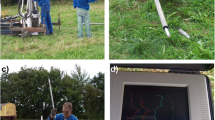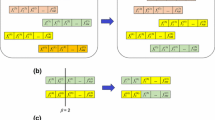Abstract
An evolutionary approach is applied to solve the nonlinear well logging inverse problem. In the framework of the proposed interval inversion method, nuclear, sonic, and laterolog resistivity data measured at an arbitrary depth interval are jointly inverted, where the depth variation of porosity, water saturation, and shale volume is expanded into series using Legendre polynomials as basis functions. In the interval inversion procedure, the series expansion coefficients are estimated by using an adaptive float-encoded genetic algorithm. Since the solution of the inverse problem using traditional linear optimization tools highly depends on the selection of the initial model, a heuristic search is necessary to reduce the initial model dependence of the interval inversion procedure. The genetic inversion strategy used in interval inversion seeks the global extreme of the objective function and provides an estimate of the vertical distribution of petrophysical parameters, even starting the inversion procedure from extremely high distances from the optimum. For a faster computational process, after a couple of thousand generations, the genetic algorithm is replaced by some linear optimization steps. The added advantage of using the Marquardt algorithm is the possibility to characterize the accuracy of the series expansion coefficients and derived petrophysical properties. A Hungarian oil field example demonstrates the feasibility and stability of the improved interval inversion method. As a significance, the genetic inversion method does not require prior knowledge or strong restrictions on the values of petrophysical properties and gives highly reliable estimation results practically independent of the initial model and core information.













Similar content being viewed by others
References
Alberty M, Hashmy K (1984) Application of ULTRA to log analysis. In: SPWLA symposium transactions. Paper Z, pp 1–17
Aleardi M (2015) Seismic velocity estimation from well log data with genetic algorithms in comparison to neural networks and multilinear approaches. J Appl Geophys 117:13–22
Aleardi M, Mazzotti A (2017) 1D elastic full-waveform inversion and uncertainty estimation by means of a hybrid genetic algorithm–Gibbs sampler approach. Geophys Prospect 65:64–85
Ali Ahmadi M, Zendehboudi S, Lohi A, Elkamel A, Chatzis I (2013) Reservoir permeability prediction by neural networks combined with hybrid genetic algorithm and particle swarm optimization. Geophys Prospect 61:582–598
Archie GE (1942) The electrical resistivity log as an aid in determining some reservoir characteristics. SPE Trans AIME 146:54–62
Baker Atlas (1996) OPTIMA, eXpress reference manual. Baker Atlas, Western Atlas International, Inc., Houston
Ball SM, Chace DM, Fertl WH (1987) The Well Data System (WDS): an advanced formation evaluation concept in a microcomputer environment. In: Proceedings of the SPE eastern regional meeting, paper 17034, pp 61–85
Chunduru RK, Sen MK, Stoffa PL (1997) Hybrid optimization methods for geophysical inversion. Geophysics 62:1196–1207
Cranganu C, Luchian H, Breaban ME (2015) Artificial intelligent approaches in petroleum geosciences. Springer, Berlin
Dobróka M, Szabó NP (2011) Interval inversion of well-logging data for objective determination of textural parameters. Acta Geophys 59:907–934
Dobróka M, Szabó NP (2012) Interval inversion of well-logging data for automatic determination of formation boundaries by using a float-encoded genetic algorithm. J Pet Sci Eng 86–87:144–152
Dobróka M, Szabó PN, Cardarelli E, Vass P (2009) 2D inversion of borehole logging data for simultaneous determination of rock interfaces and petrophysical parameters. Acta Geod Geophys Hung 44:459–479
Dobróka M, Szabó NP, Turai E (2012) Interval inversion of borehole data for petrophysical characterization of complex reservoirs. Acta Geod Geophys Hung 47:172–184
Dobróka M, Szabó NP, Tóth J, Vass P (2016) Interval inversion approach for an improved interpretation of well logs. Geophysics 81:D155–D167
Dorrington KP, Link CA (2004) Genetic-algorithm/neural-network approach to seismic attribute selection for well-log prediction. Geophysics 69:212–221
Drahos D (2005) Inversion of engineering geophysical penetration sounding logs measured along a profile. Acta Geod Geophys Hung 40:193–202
Eidsvik J, Mukerji T, Switzer P (2004) Estimation of geological attributes from a well log: an application of hidden Markov chains. Math Geol 36:379–397
Gajda-Zagórska E, Schaefer R, Smołka M, Paszyński M, Pardo D (2015) A hybrid method for inversion of 3D DC resistivity logging measurements. Nat Comput 14:355–374
Galsa A, Herein M, Drahos D, Herein A (2016) Effect of the eccentricity of normal resistivity borehole tools on the current field and resistivity measurement. J Appl Geophys 134:281–290
Holland JH (1975) Adaptation in natural and artificial systems. University of Michigan Press, Ann Arbor
Horváth SB (1973) The accuracy of petrophysical parameters as derived by computer processing. Log Anal 14:16–33
Houck CR, Joines JA, Kay MG (1995) A genetic algorithm for function optimization: a Matlab implementation. NCSU-IE technical report 95-09, North Carolina State University, pp 1–14
Jarzyna JA, Cichy A, Drahos D, Galsa A, Bała MJ, Ossowski A (2016) New methods for modeling laterolog resistivity corrections. Acta Geophys 64:417–442
Lindberg DV, Grana D (2015) Petro-elastic log-facies classification using the expectation–maximization algorithm and hidden Markov models. Math Geosci 47:719–752
Malkoti A, Vedanti N, Bhattacharya AK (2017) Inversion of well log data using improved shale model for determination of petrophysical parameters. J Indian Geophys Union 21:96–104
Marquardt DW (1959) Solution of nonlinear chemical engineering models. Chem Eng Prog 55:65–70
Mayer C, Sibbit AM (1980) GLOBAL, a new approach to computer-processed log interpretation. In: Proceedings of the 55th SPE annual fall technical conference and exhibition, paper 9341, pp 1–14
Menke W (1984) Geophysical data analysis: discrete inverse theory. Academic Press, Cambridge
Michalewicz Z (1992) Genetic algorithms + data structures = evolution programs. Springer, Berlin
Mundim KC, Lemaire TJ, Bassrei A (1998) Optimization of non-linear gravity models through generalized simulated annealing. Physica A 252:405–416
Narayan JP, Yadav L (2006) Application of adaptive processing technique for the inversion of open hole logs recorded in oil fields of Indian basins. In: Proceedings of the SPG 6th international conference and exposition on petroleum geophysics, pp 505–512
Sambridge M (1999) Geophysical inversion with a neighbourhood algorithm—I. Searching a parameter space. Geophys J Int 138:479–494
Sambridge M, Drijkoningen G (1992) Genetic algorithms in seismic waveform inversion. Geophys J Int 109:323–342
Schlumberger (1989) Log interpretation principles/applications. Seventh printing. Schlumberger, Houston
Sen MK, Stoffa PL (1995) Global optimization methods in geophysical inversion. Elsevier, Amsterdam
Szabó NP (2004) Global inversion of well log data. Geophys Trans 44:313–329
Szabó NP (2016) Hydrocarbon formation evaluation using an efficient genetic algorithm-based factor analysis method. In: Proceedings of the 15th European conference on the mathematics of oil recovery, paper Mo P071, pp 1–12
Szabó NP, Dobróka M (2013) Extending the application of a shale volume estimation formula derived from factor analysis of wireline logging data. Math Geosci 45:837–850
Szabó NP, Dobróka M (2018) Exploratory factor analysis of wireline logs using a float-encoded genetic algorithm. Math Geosci 50:317–335
Szabó NP, Balogh GP, Stickel J (2018) Most frequent value-based factor analysis of direct-push logging data. Geophys Prospect 66:530–548
Szijártó M, Balázs L, Drahos D, Galsa A (2017) Numerical sensitivity test of three-electrode laterolog borehole tool. Acta Geophys 65:701–712
Szűcs P, Civan F (1996) Multi-layer well log interpretation using the simulated annealing method. J Pet Sci Eng 14:209–220
Tarantola A (2005) Inverse problem theory and methods for model parameter estimation. Society of Industrial and Applied Mathematics (SIAM), Philadelphia
Tlas M, Asfahani J (2008) Using of the adaptive simulated annealing (ASA) for quantitative interpretation of self-potential anomalies due to simple geometrical structures. J King Abdulaziz Univ Earth Sci 19:99–118
Toushmalani R (2013) Comparison result of inversion of gravity data of a fault by particle swarm optimization and Levenberg–Marquardt methods. SpringerPlus 2:462
Woznicka U, Jarzyna J, Cichy A (2009) Forward modelling and inverse problem in the comprehensive interpretation of well logs. Geophys Prospect 57:99–109
Wyllie MRJ, Gregory AR, Gardner LW (1956) Elastic wave velocities in heterogeneous and porous media. Geophysics 21:41–70
Yang XS (2013) Metaheuristic algorithms for inverse problems. Int J Innov Comput Appl 5:76–84
Acknowledgements
This research was supported by the GINOP-2.3.2-15-2016-00010 “Development of enhanced engineering methods with the aim at utilization of subterranean energy resources” project in the framework of the Széchenyi 2020 Plan, funded by the European Union, co-financed by the European Structural and Investment Funds.
Author information
Authors and Affiliations
Corresponding author
Rights and permissions
About this article
Cite this article
Szabó, N.P., Dobróka, M. Series Expansion-Based Genetic Inversion of Wireline Logging Data. Math Geosci 51, 811–835 (2019). https://doi.org/10.1007/s11004-018-9768-4
Received:
Accepted:
Published:
Issue Date:
DOI: https://doi.org/10.1007/s11004-018-9768-4




